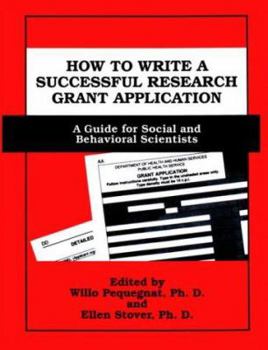How to Write a Successful Research Grant Application: A Guide for Social and Behavioral Scientists
This unique volume provides technical assistance for researchers applying for biobehavioral or psychosocial research funding. Although its focus is on Public Health Service (PHS) funding, the guide is... This description may be from another edition of this product.
Format:Paperback
Language:English
ISBN:030644965X
ISBN13:9780306449659
Release Date:September 1995
Publisher:Springer
Length:252 Pages
Weight:1.30 lbs.
Dimensions:10.0" x 0.8" x 7.3"
Customer Reviews
1 rating
Getting past the government gobbledegook.
Published by Thriftbooks.com User , 24 years ago
Most persons pursuing careers in higher education are expected to engage in research and seek funding for those efforts. In most universities, "research" is considered one of the three legs of the stool of knowledge. Moreover, doing "research" typically implies that the academic seek outside funding to pay for those research activities. Although there are many sources of research funding, the federal government stands out as the most significant source of research support. Therefore, when a group of senior level managers with funding responsibilities write a book describing the funding process, and some of the secrets and pitfalls of the process, those developing research grant applications would do well to become familiar with this book.Pequegnat and Stover hold senior level positions in the US National Institute of Mental Health and specialize in behavioral research relating to AIDS. The book they have developed brings together more than 30 contributors who have worked in various aspects of AIDS research, many from positions at NIMH, and others from University or other research viewpoints. Because of this focus, most of the book focuses on the processes particular to NIMH and uses AIDS research as the focus for examples. It is obvious, however, that the principles and processes laid out will be useful to those seeking research support from other federal program agencies, as well as from state, industry or private funding entities. The book has three sections and 20 chapters. Section I deals with "Grantsmanship and the Review Process;" its eight chapters lay out several important considerations for any person interested in developing a research application. The pieces deal with the general philosophy of a research program, gathering information from government communications, and an overview of the ways in which a government agency views submissions from university or other researchers. This section also addresses matters relating to research design, hypothesis development, and even ways to better understand and use feedback from application reviewers.The ten chapters of section II deal with "Developing Sections of Your Research Application" and provide a wealth of applicable information about developing exciting hypotheses for testing, using qualitative inquiry instrumentation, relating to, and gaining assistance from other disciplines, and some nuts-and-bolts issues relating to human subjects, budget, the data analytic plan, and even presentation of staff resumes to support and strengthen the grant application package.Section III, with two chapters covers "Disseminating Your Findings." This section addresses delivering a talk about the research, and a final chapter provides a great deal of detail on adding visuals to presentations-charts graphs and other support materials. Three appendix sections provide an actual example of a successful research application and addresses issues such as data analysis, budget justification and othe






